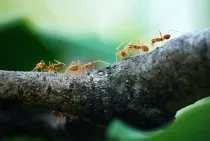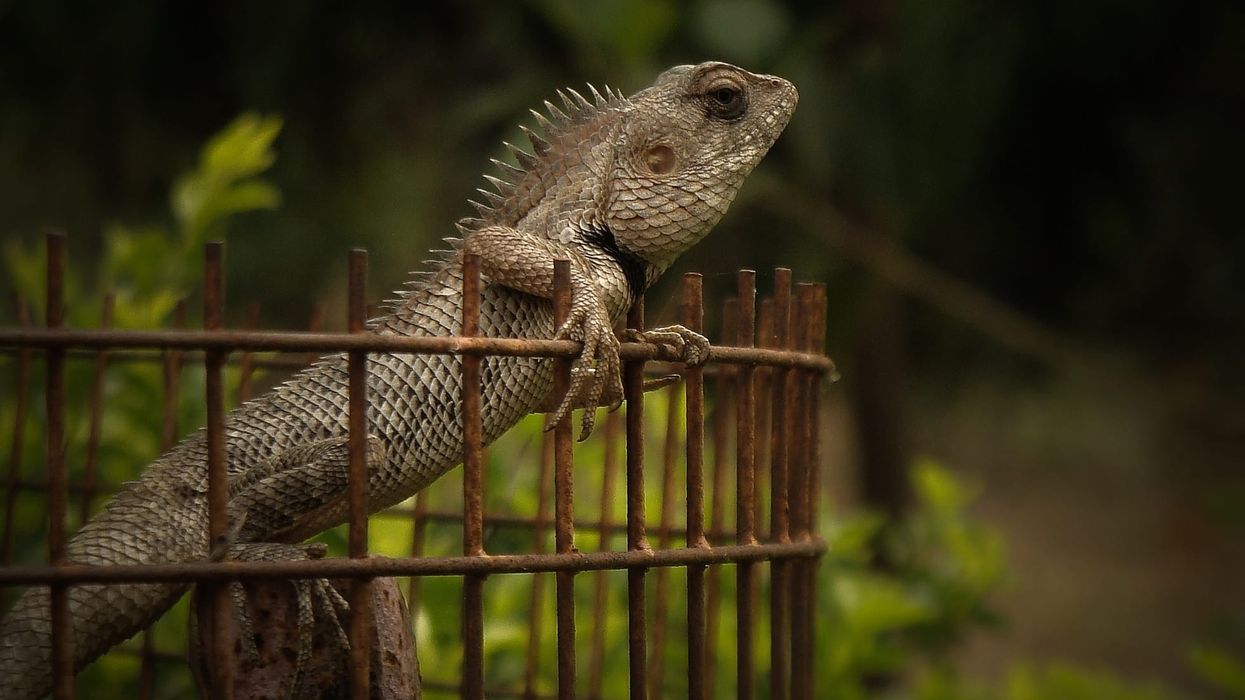Leafcutter ants are also called cut ants or parasol ants. Leafcutter ants split up from a common ancestor species into the two genera Atta and Acromyrmex, about 10 million years ago.
Both Acromyrmex species and Atta species ants are similar. Atta ants have three spines and a smooth exoskeleton, while Acromyrmex ants have four pairs of spines and a rough exoskeleton.
These ants are hardworking and interesting creatures known as fungus farmers. Leafcutter ants have special jaws that cut off leaves and are said to be one of the strongest animals with their powerful jaws and said to carry 50 times their weight.
They can carry leaves twenty times their body weight to their nests. They cultivate their fungal gardens with these freshly cut leaves, their food source.
These leafcutting ants increase soil fertility by tilling the soil with their nest building and by their fungus garden in the nests. These soils are rich in nutrients like organic carbon, nitrogen, potassium, phosphorous, and magnesium, fit for cultivation.
While learning about leafcutter ants facts, check out similar articles on the mud dauber wasp and yellow jacket wasp.
Leafcutter Ant Interesting Facts
What type of animal is a leafcutter ant?
Leafcutter ants are complex insects that eat rainforest vegetation.
What class of animal does a leafcutter ant belong to?
Leafcutter ants belong to the Insecta Class of Hymenoptera Order.
How many leafcutter ants are there in the world?
The exact count of leaf cutter ants is not known. However, about 47 species of leaf-cutting ants are the Atta and the Acromyrmex.
Where does a leafcutter ant live?
Leafcutter ants live in nests built in various forest floors and artificial habitats, which resemble a sandcastle. These ants construct an underground web of thousands of chambers that are connected by a tunnel network.
One nest can be upto over 100 sq ft (9.3 sq m) in area and 10-12 ft (3.1-3.7 m) underground. Leafcutter ants generally build their nests in well-drained sandy or loamy soils.
What is a leafcutter ant's habitat?
They are found in tropical forests of Central and South America, Mexico, and some parts of the Southern United States.
Who do leafcutter ants live with?
They prefer to live in their giant colonies on the forest floor, which can accommodate nearly 10 million ants.
How long does a leafcutter ant live?
The leafcutter ants can live up to 6-10 weeks. However, a leafcutter colony can exist for thousands of years.
How do they reproduce?
Each female mates with multiple males and collect 300 million sperm. The female ant is called a queen.
It finds a suitable place on the forest floor and some fungus to establish a new colony. Not all queens can build a colony; only 2.5% will establish a long-lived colony. Once a colony is established, the leafcutter ant queen leads the new colony and lays eggs for the rest of their life.
What is their conservation status?
As leafcutter ants' conservation status is listed as Least Concern, they are abundant on forest floors. They are generally considered pests because they cut leaves from crops; but, these ants play an essential role in maintaining balance in nature. They decompose fallen leaves and encourage new plant growth by adding nutrients to the soil with their fungus gardens.
Leafcutter Ant Fun Facts
What do leafcutter ants look like?

Leaf cutter ants have spiny, reddish-brown bodies with jointed legs. Like other ants, it has three main body parts: the head, thorax, and abdomen. These ants have a hard outer covering known as an exoskeleton and a pair of antennae. Leaf cutter ants use these antennae as an important sense organ.
Even though leaf cutter ants play a vital role in the rainforest ecosystem by decomposing rainforest vegetation, these ants have unique capabilities and, in their enormous colonies, can be a bit scary to watch.
How cute are they?
The leaf cutter ant, mainly found in America, looks cute, although they are pretty strange looking.
How do they communicate?
Leafcutter ants communicate with the substrate-borne vibrations produced by stridulation. These stridulatory signals are noticed when ants search for food, alarm situations, and collective nest building.
How big is a leafcutter ant?
Leafcutters are giant ants with long legs. The queen leafcutter ants will be 1 in (25.4 mm) long. Male leafcutter ants are 0.5 in (12.7 mm) long. Simultaneously, the worker leaf-cutter ants range from 0.08-0.5 in (2-12.7 mm).
How fast can leafcutter ants move?
If scaled up to human size, it could run ten miles at a speed of 16 mph (25.8 kph). It could cover each mile in 3 minutes and 45 seconds, close to humans.
How much does a leafcutter ant weigh?
The average weight of any ant ranges from 0.000002-0.00001 lb (1-5 g 1-5 mg). This leafcutter belonging to the same family of Formicidae could have the comparatively same weight or slightly on the upper side as there are more enormous ants.
What are the male and female names of the species?
Adult male leafcutter ants are called drones, and adult female leafcutter ants become a queen, also termed a gyne.
What would you call a baby leafcutter ant?
Like other ant species, leafcutter ants undergo four stages of development from egg to larva, then a pupa and finally turn into an adult ant.
What do they eat?
Leafcutter ants use their jaws to cut leaves into pieces. It is estimated that they cut about 12-15% of the amount of vegetation in the rainforests of South America.
They carry these pieces of leaves to their nest in the forest and grow fungus gardens they use as their food for ants' larvae, whereas adult ants get their nutrients from leaf saps.
Are they harmful?
Leaf-cutter ants can severely affect agricultural fields and even damage roads and structures with their nest-making activities. Some research found that the Atta species can destroy an entire citrus tree in less than 24 hours. They are dangerous and harmful to agricultural fields.
Would they make a good pet?
Leaf-cutter ants live in massive colonies and can be a severe agricultural threat as they remove foliage, so they cannot make a good pet.
Did you know...
These ants, based on sizes, are divided into castes, namely minims, minors, mediae, and majors, to perform different duties. Minims are the smallest workers who look after the fungus gardens.
Minors, next to minima workers, guard the nest against enemies within the foraging lines. Mediae carries the leaves to the nest. Majors are the most prominent worker ants called soldiers, defend the nest from intruders and carry large leaves.
The armadillo is the largest natural predator of leafcutter ants.
The easiest way to kill leafcutter ants is to drench or spray the mounds with Dominion 2L or Conquer.
Leafcutter ant bites
Leafcutter ants survive in rainforests and are mostly not found as indoor pests as they do not eat human food. It doesn't bite usually, but when they feel threatened, they do bite. Leafcutter ant bites can pierce human skin, as they have potent mandibles.
Leafcutter ants within the food chain
With the leaves in the rain forest, leafcutter ants grow fungus of the family Lepiotaceae in their fungal garden. A bacterium that grows on the ants secretes antimicrobials, identifying the toxic plant.
There is a mutual relationship between fungal growth and the ants. The fungus garden can't survive without the ant's larvae, and the ants can't survive without the fungus.
Here at Kidadl, we have carefully created lots of interesting family-friendly animal facts for everyone to discover! Learn more about some other arthropods including giant African millipede, or atlas beetle.
You can even occupy yourself at home by drawing one on our bug coloring pages.










